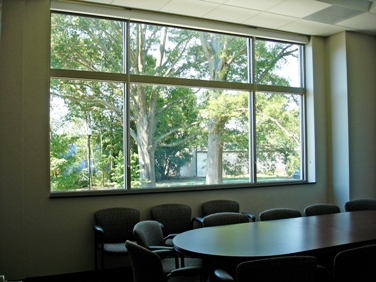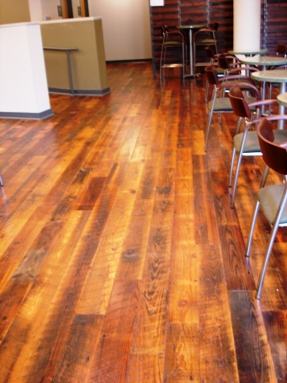 The Wake Forest Town Hall earned LEED Platinum certification in November 2011. It is one of only a handful of municipal buildings in the United States to receive Platinum status.
The Wake Forest Town Hall earned LEED Platinum certification in November 2011. It is one of only a handful of municipal buildings in the United States to receive Platinum status.
LEED certification identifies the facility as a pioneering example of sustainable design. The "Leadership in Energy and Environmental Design" (LEED) green building rating system encourages and accelerates global adoption of sustainable green building and development practices through the creation and implementation of universally understood and accepted tools and performance criteria. LEED promotes a whole building approach to sustainability by recognizing performance in five key areas of human and environmental health: sustainable site development, water savings, energy efficiency, materials selection and indoor environmental quality. LEED certification provides independent, third-party verification that a building project provides an environmentally responsible, profitable and healthy place to live and work.
The following overview identifies several "green" features incorporated in the design and construction of Wake Forest's new Town Hall:
Air Distribution System & Natural Lighting
An energy efficient under-floor air distribution system provides considerable thermal and air control for employees who work in town hall. Carbon dioxide sensors make sure sufficient outside air is entering the building without letting in more than is necessary to impact heating and cooling.
Maximized day lighting with lighting controls significantly reduces the building's lighting load, while also providing all occupants with incredible views of the outdoors.
These energy efficient systems and strategies will result in a 24.7% reduction in energy costs. In addition, 70% of the anticipated energy use is being offset with green power, including wind and solar farms throughout the country.
Energy Efficiency
 Most of the light switches in the Wake Forest Town Hall have occupancy sensors which conserve electricity by turning on the lights when movement is detected in a room and then turning off the lights when no one is present. Compact fluorescent lamps (CFLs) are used instead of incandescent lamps whenever possible because they give the same amount of visible light while using less power and last longer.
Most of the light switches in the Wake Forest Town Hall have occupancy sensors which conserve electricity by turning on the lights when movement is detected in a room and then turning off the lights when no one is present. Compact fluorescent lamps (CFLs) are used instead of incandescent lamps whenever possible because they give the same amount of visible light while using less power and last longer.
Commissioning Agent
In an effort to ensure the proper construction and efficient operation of the facility, the Town hired a commissioning agent who will track the energy savings and ensure the verification plan is implemented.
Site Features
The site was developed with environmental concerns in mind. For example, dedicated parking spaces have been provided for carpooling and fuel-efficient/low-emitting vehicles, along with bicycle racks for employees and customers who wish to ride their bikes to town hall. It also maximizes open space while preserving and restoring the native habitat. Other site elements incorporated in the site design include measures that will reduce the heat-island effect, such as reflective roofing and paving.
Water Conservation
The Wake Forest Town Hall project went above and beyond what is required by LEED. The facility is designed to significantly reduce the use of potable water by utilizing non-potable water for landscape irrigation (saves 100% of potable water) and ultra low-flush toilets and urinals, as well as ultra low-flow fixtures for lavatories, shower, and kitchen areas (saves 41.6% of potable water).
In addition, the sinks in all of the restrooms are equipped with sensors that turn on the water when motion is detected in the bowl, and automatically turn off the water when not in use.
Building Materials
The construction materials used in town hall were not only selected for their natural beauty, but also for their sustainable qualities, including:
- Recycled content – reduces use of raw materials and resources.
- Originated or remanufactured in North Carolina – reduces transportation carbon footprint and supports regional economy.
- Low maintenance – reduces the need for frequent maintenance chemical use.
- Weathers nicely – eliminates the need for frequent cleaning, painting or sealants.
- Durable – withstands wear and extends the useful life of the material.
Significant amounts of construction waste were diverted from the landfill through re-use and recycling.
Additionally, the materials used for the project include considerable recycled content - most of which was extracted and manufactured within 500 miles of Wake Forest. A majority of the wood installed throughout the project was forested responsibly, while many other materials were derived from rapidly renewable sources, such as bamboo and wheat.
LED Light Installation
The town installed energy-saving LED street lights in the parking lots of town hall. LED street lights use between 35 and 67 percent of the energy required for a comparable standard high pressure light.
VOCs
During construction, the team was diligent not to allow products with excessive VOC (volatile organic compounds) or urea-formaldehyde composite woods into the building. At the end of construction, the building was "flushed" to ensure the new occupants had clean air to breath.

